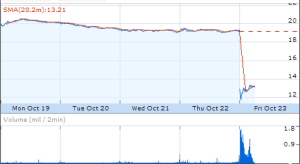“Pandora exited Q3 with strong financial results,” the company’s earnings summary states. “In a quarter where a large new entrant came into the music streaming landscape and over a hundred million dollars in combined marketing was spent across the sector to drive awareness of a multitude of offerings, Pandora more than held its own for users and hours growth.”
 Investors didn’t get the memo, or didn’t like it, as Pandora stock traded a shocking 33% down from yesterday’s closing price at one point this morning. The “large new entrant” (Apple Music) might be frightening to traders. Additionally, Pandora’s gross profit number was lower than for any quarter since Q1 2014, and the net loss of $86-million was a deeper dive into red ink than Pandora showed in the last 11 quarters. (The company’s Consolidated Statements of Operations documents results back to Q3 2013.)
Investors didn’t get the memo, or didn’t like it, as Pandora stock traded a shocking 33% down from yesterday’s closing price at one point this morning. The “large new entrant” (Apple Music) might be frightening to traders. Additionally, Pandora’s gross profit number was lower than for any quarter since Q1 2014, and the net loss of $86-million was a deeper dive into red ink than Pandora showed in the last 11 quarters. (The company’s Consolidated Statements of Operations documents results back to Q3 2013.)
“In the third quarter our strong monetization engine continued to produce record results,” CEO Brian McAndrews said during the earnings call. He was referring to a key metric sometimes forgotten in press coverage: RPM, or revenue per thousand listening hours. That number is a measure of how efficiently Pandora makes money from its streams. In Q3 the number rose to $60.42 overall, and $56.84 from advertising. (Pandora makes most of its money from ad sales, but also extracts revenue from user subscriptions to its ad-free service.) The RPM is up 26% year-over-year. In Q2 the overall RPM was $53.91 (as we reported here).
Key financial points:
- Pandora booked $312-million in revenue during the quarter, a nine percent gain over Q2, and +30% year-over-year.
- Total ad revenue was $255-million, 31% better than last year’s Q3.
- Mobile revenue grew 36% to $255-million.
- Local advertising was at $64-million, representing a whopping 52% gain year-over-year — that number represents the company’s investment in local sales forces in dozens of radio markets, executing against the core mission of taking advertising share from traditional radio.
- Cost of revenue rose 55% quarter-over-quarter.
- Full-year guidance for the next report puts revenue above $1-billion for the first time in a fiscal year. The estimate is about $1.15-billion.
Listener metrics are scrutinized during these calls, in addition to finances.
- Listener hours were at 5.14-billion, a 3% yearly growth.
- Pandora had 78.1-million monthly active listeners, compared to 79-4-million last quarter.
Pandora’s galloping growth that it enjoyed leading into 2014 has slowed, and that bothers investors. It is not unexpected, though, as the field becomes more crowded and Pandora continues its strategies of increasing monetization efficiency and deepening the U.S. opportunity while resisting international expansion. Outside the U.S., Pandora operates only in Australia and New Zealand. Expanding into many national territories is difficult for a non-interactive radio service, due to different music licensing regulations. Brands like Spotify and Deezer, interactive services which sprawl the globe, directly negotiate licensing deals that can more easily cross borders.

